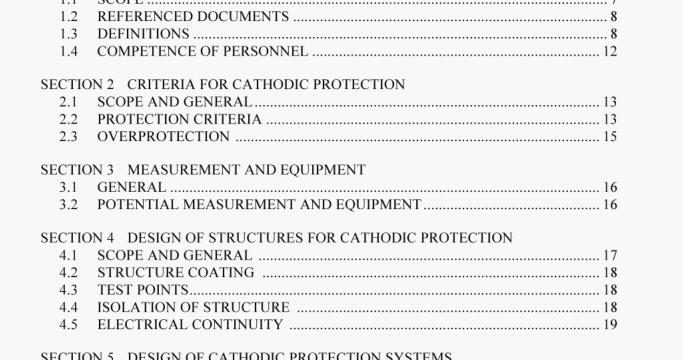AS 2832.3-2005 pdf download.Cathodic protection of metals Part 3 : Fixed immersed structures.
This Section specifies the criteria for determining when the appropriate amount and distribution of direct current is being applied to the structure.
2.1.2 General
Metals may be protected from corrosion b the application of direct current to lower and maintain the potential of the metal sufTicientis negative with respect to the environment. The direct current is provided by the use of an impressed current system. galvanic anodes. or a coinbinat ion of both. The potential of a structure with respect to its environment can give a reliable indication of the degree of protection being provided.
The protection criteria are given in Clause 2.2. These criteria are with reference to either a copper/copper sulphate electrode or a silverJsilver chloride electrode. This latter electrode is commonly used in marine and brackish water conditions, whereas the former is used on land and in fresh water. Either electrode can be used in both situations: however, the copper/copper sulphate electrode can become rapidly contaminated by chloride ions. whereas the silver/silver chloride electrode gives differing readings, depending on the concentration of the chloride in the environment. For measuring the potential of a structure using the off-potential method refer to Appendix B.
NOTE: Where a silver”silver chloride reference electrode is of the type which has the central billet directly exposed to the electrolyte in which it is immersed, rather than being encapsulated in a chloride ion-rich electrolyte. the protection criteria will vary with the change in concentration of chloride ions present, requiring appropriate correction to the measured value. This type of silver,silver chloride reference electrode is mainly used in sea water where the chloride ion concentration is substantially constant, see Appendix C.
Other reference electrodes may be used as alternatives to copper/copper sulfate and silver/silver chloride, provided that their relativity to these reference electrodes has been established.
NOTE: Criteria other than those listed may be used, if their efficacy has been established, see Appendix H.
2.2 PROTECTION CRITERIA
2.2.1 General
Protection criteria are with reference to either a copper/copper sulfate electrode or a silver/silver chloride electrode. This latter electrode is commonly used in marine conditions, whereas the former is normally used on land and in fresh water conditions. [he copper/copper sulfate electrode can become rapidly contaminated by chloride ions.
2.2.2 Ferrous structures
The accepted practices for the protection of ferrous structures are as follows:
2.2.3 Aluminium structures
The accepted practice for the protection of a submerged aluminium structure is to maintain a potential on all parts of the structure equal to. or more negative than. •900 mV, but not more negative than —1050 mV with respect to a copper/copper sulfate reference electrode.
2.2.4 Mixed metallic structures
The accepted practice for the protection of mixed metallic structures is to maintain a negative potential on all parts of the structure at least equal to that required for the most anodic metal between all structure surfaces and a copper/copper sulfate reference electrode.
2.2. Structures subject to variable stray current effects
Variable stray traction and telluric current shall be evaluated when there is an indication that the structure potentials are varying, and shall be evaluated by carrying out a data- logger or chart recording of potentials in accordance with this Clause. It is very rare to encounter telluric effects on fixed immersed structures If encountered, the same criteria shall he applicable.
The response of a structure to stray current excursions is dependent upon many factors including electrolte resistivity, degree of aeration and structure coating quality, if any. The magnitude of the stray current excursions will also he dependent on the proximity of the source. The extent of a depolarization is determined by the frequency. magnitude and the duration of anodic excursions.
The measured potential is the sum of the polarized structure potential and the potential from the voltage gradient in the electrolyte. When potentials are affected by stray currents, it may not be possible to determine whether they are free of voltage gradients, and thus to coin pare the measured potential with the protection criterion. In such cases, an estimation of the electrolyte voltage gradient will suffice to determine compliance with the protection criterion.
NOTE: Refer to Appendix C for guidance on the calibration and maintenance of reference electrodes and Appendix F for the frequency of inspection for structures.
Where structures are required o be evaluated for stray traction current effects, ii is necessary to record the potential during a sufficient period of time to ensure that the maximum exposure to the sray current effects is encompassed. This period shall include the morning and evening usage peaks and is nominally twenty hours. If a data-logger is used for the monitoring of potential. its frequency of sampling shall be not less than four samples per minute.
‘ihe protection criteria for structures subject to traction current elTects varies with the structure polarization time as follows:AS 2832.3-2005 pdf download.Cathodic protection of metals
Cathodic protection of metals
